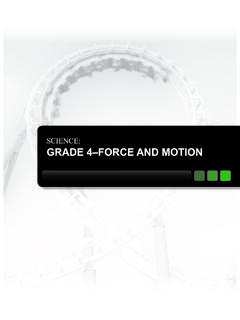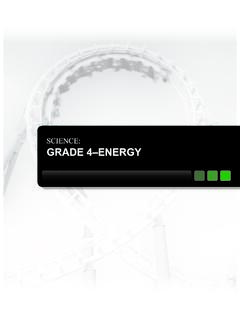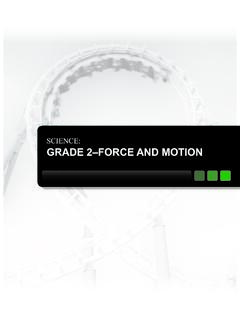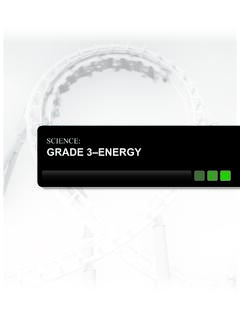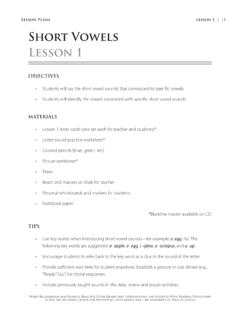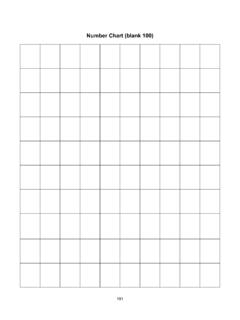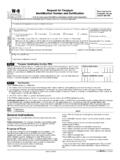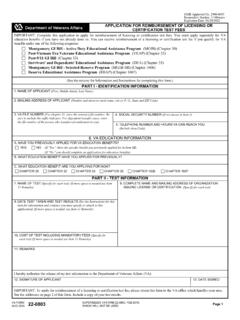Transcription of Lesson Plans Lesson 4 | Consonant Blends Lesson 4
1 Word Recognition and Fluency: Effective Upper-Elementary Interventions for Students With Reading Difficulties 2010 The Meadows Center for Preventing Educational Risk, the University of Texas at AustinLesson Plans Lesson 4 | 61 Word Recognition and Fluency: Effective Upper-Elementary Interventions for Students With Reading Difficulties 2010 The Meadows Center for Preventing Educational Risk, the University of Texas at AustinConsonant BlendsLesson 4 OBJECTIVES Students will read initial and final Consonant Blends in closed-syllable words. Students will spell initial and final Consonant Blends in closed-syllable Letter cards from previous lessons* Lesson 4 word cards* Word sort category cards* Word grid worksheet* Word sort graphic organizer* Pocket chart Board and markers or chalk for teacher Personal whiteboards and markers for students Notebook paper*Blackline master available on Refer to the Appendix for list of beginning and ending Consonant Blends and Consonant -blend words.
2 Enunciate words and listen carefully as students repeat to ensure they articulate the Consonant | Lesson 4 Lesson PlansWord Recognition and Fluency: Effective Upper-Elementary Interventions for Students With Reading Difficulties 2010 The Meadows Center for Preventing Educational Risk, the University of Texas at AustinWord Recognition and Fluency: Effective Upper-Elementary Interventions for Students With Reading Difficulties 2010 The Meadows Center for Preventing Educational Risk, the University of Texas at Austin Discriminate: Introduce more than one Consonant blend at a time, so students learn to use their letter-sound knowledge to discriminate among different Blends . Introduce and discriminate between two-letter Consonant Blends and three-letter Consonant Blends . Include digraph Blends (a digraph that Blends with a Consonant , as in shrimp and three), so students can discriminate between a digraph blend and Consonant blend.
3 Teach students that certain combinations of vowels and Blends make unexpected sounds in closed syllables. For example, the vowel in olt, ild, ind, ost, and old is sometimes long (colt, wild, find, most, cold). Decode and encode, using real words and nonsense words. Give direct feedback to students. DAILY REVIEW DIGRAPHS, CONSONANTSR eview by asking students to produce the sounds for specific consonants and digraphs. Ask for individual and group responses, and randomize the order in which you point to the letters. Keep a brisk : Let s start by quickly reviewing some consonants. I will point to a letter, and you will tell me its sound. Be alert because I will go quickly! Remember that the cue I give when it s time for you to repeat is an open palm. [Point to d and gesture.]Students: /d/Teacher: Correct, /d/. [Point to r and gesture.]
4 ]Students: /r/Word Recognition and Fluency: Effective Upper-Elementary Interventions for Students With Reading Difficulties 2010 The Meadows Center for Preventing Educational Risk, the University of Texas at AustinLesson Plans Lesson 4 | 63 Word Recognition and Fluency: Effective Upper-Elementary Interventions for Students With Reading Difficulties 2010 The Meadows Center for Preventing Educational Risk, the University of Texas at Austin Teacher: Yes, /r/. [Point to s.] Hector, what sound? Hector: /s/[Continue reviewing desired Consonant sounds.]Teacher: Now, we will move on to digraphs. How many letters does a digraph have, Jennifer?Jennifer: : And how many sounds does a digraph make, Aaliyah?Aaliyah: the digraph sounds /sh/, /th/, /ck/, /ph/, /wh/, and /ch/ by pointing to digraph cards and asking students to say the : Today s Lesson is about Consonant Blends .
5 You will learn how to read words that have two or three consonants right next to each other, but unlike digraphs, each letter keeps its sound. This Lesson is important because longer and more difficult words contain Consonant Blends , so you will be able to read and spell more words when you learn this AND TEACH: ACTIVITY 1 BLENDING SOUNDS DECODINGU sing letter cards, have students read the word shop and say the number of letters (four) and sounds (three). Compare students answers to the number of letters and sounds in stop. Explain again that Consonant Blends are two or three consonants right next to each other and that each letter makes its own sound. Point out that Blends can appear at the beginning or end of words. 64 | Lesson 4 Lesson PlansWord Recognition and Fluency: Effective Upper-Elementary Interventions for Students With Reading Difficulties 2010 The Meadows Center for Preventing Educational Risk, the University of Texas at AustinWord Recognition and Fluency: Effective Upper-Elementary Interventions for Students With Reading Difficulties 2010 The Meadows Center for Preventing Educational Risk, the University of Texas at Austin[Using letter cards, display the word shop in the pocket chart .]
6 ]Teacher: Please read this word. Students: shop Teacher: Correct, the word is shop. Hector, how many letters in shop?Hector: S-h-o-p: four : And how many sounds in shop, Jennifer?Jennifer: /sh/ /o/ /p/: There are three sounds because the sh makes the one sound, /sh/.Teacher: Perfect! Watch as I remove s and h and replace them with s and t. This is a word you see frequently, so you probably already know : stopTeacher: That s right. I ll ask the same question as before. How many letters in stop?Students: : Listen as I count the number of sounds. [Use your fingers to count.]Teacher: /s/ /t/ /o/ /p/: There are four sounds because s and t each have their own sound. A blend is when two consonants next to each other make two sounds, like s and t in stop. You blend the sounds together, just as you do with CVC words. Watch how I blend this word.
7 [Place the letters s, p, i, and n in the pocket chart , leaving space between the letters. Point to s and say /s/. Point to p and say /p/.Teacher: /sp/: That s the blend. Say /sp/. Students: /sp/[Point to i and say /i/. Point to n and say /n/.]Teacher: Your turn. Say the sounds as I slide my finger under each sound. Word Recognition and Fluency: Effective Upper-Elementary Interventions for Students With Reading Difficulties 2010 The Meadows Center for Preventing Educational Risk, the University of Texas at AustinLesson Plans Lesson 4 | 65 Word Recognition and Fluency: Effective Upper-Elementary Interventions for Students With Reading Difficulties 2010 The Meadows Center for Preventing Educational Risk, the University of Texas at AustinStudents: /sp/ /i/ /n/[Slide your finger under the whole word.]Teacher: spinStudents: spinUsing this sequence, blend several more words with beginning Consonant Blends ( , flag, skin, crop, drum).]
8 Teacher: Aaliyah, with your finger, draw a line under the blend in drum. [Aaliyah underlines dr.] That s right. Does the blend appear before or after the vowel?Aaliyah: Before.[Using letter cards, display the word desk and have students blend it.]Teacher: Where is the blend in desk, Kevin?Kevin: At the end of the : Right, it comes after the vowel. You can see that Consonant Blends can be at the beginning or the end of a letter cards, blend several more four-sound words with beginning or ending Consonant Blends ( , flag, sent, crop, dump). ERROR CORRECTIONT hrough questioning, guide students who make an error with a blend to identify the location and number of letters in the blend. Remind students that each Consonant in a blend makes a sound (with the exception of digraph Blends ). Have students repeat the blending sequence to read the | Lesson 4 Lesson PlansWord Recognition and Fluency: Effective Upper-Elementary Interventions for Students With Reading Difficulties 2010 The Meadows Center for Preventing Educational Risk, the University of Texas at AustinWord Recognition and Fluency: Effective Upper-Elementary Interventions for Students With Reading Difficulties 2010 The Meadows Center for Preventing Educational Risk, the University of Texas at AustinADAPTATIONU sing the same instructional sequence, extend the Lesson to demonstrate closed-syllable words with additional Blends .
9 Include examples from earlier Consonant -blend concepts. Make sure that students master one type of blend before moving on to the next. Digraph Blends : These Blends consist of a digraph and a Consonant ( , lunch, shred). Note the difference between the number of letters and sounds in these words. Words with two-letter initial and final Blends : After mastering words containing four sounds, introduce closed syllables containing five sounds, with Blends at the beginning and end of a word ( , plant, blend, clump, shrimp). Words with three-letter Blends : Introduce words containing three-letter Blends ( , splash, scrap, script, tempt). MODEL AND TEACH: ACTIVITY 2 SEGMENTING SOUNDSENCODINGHave students use letter cards to encode words containing Consonant Blends by following this sequence:1. Dictate a Have a student repeat the word (listen for correctness).
10 3. Have the student say each sound in the word and count the sounds in the Have the student say the letters in the Have the student say the letters again as he or she collects the corresponding letter Have the student check by reading the : I will show you some steps to follow when you spell words. Listen. The first word is flop. What is the word? Students: flop Next, I count the sounds I hear in the word. Word Recognition and Fluency: Effective Upper-Elementary Interventions for Students With Reading Difficulties 2010 The Meadows Center for Preventing Educational Risk, the University of Texas at AustinLesson Plans Lesson 4 | 67 Word Recognition and Fluency: Effective Upper-Elementary Interventions for Students With Reading Difficulties 2010 The Meadows Center for Preventing Educational Risk, the University of Texas at Austin[Model counting with your fingers.]

